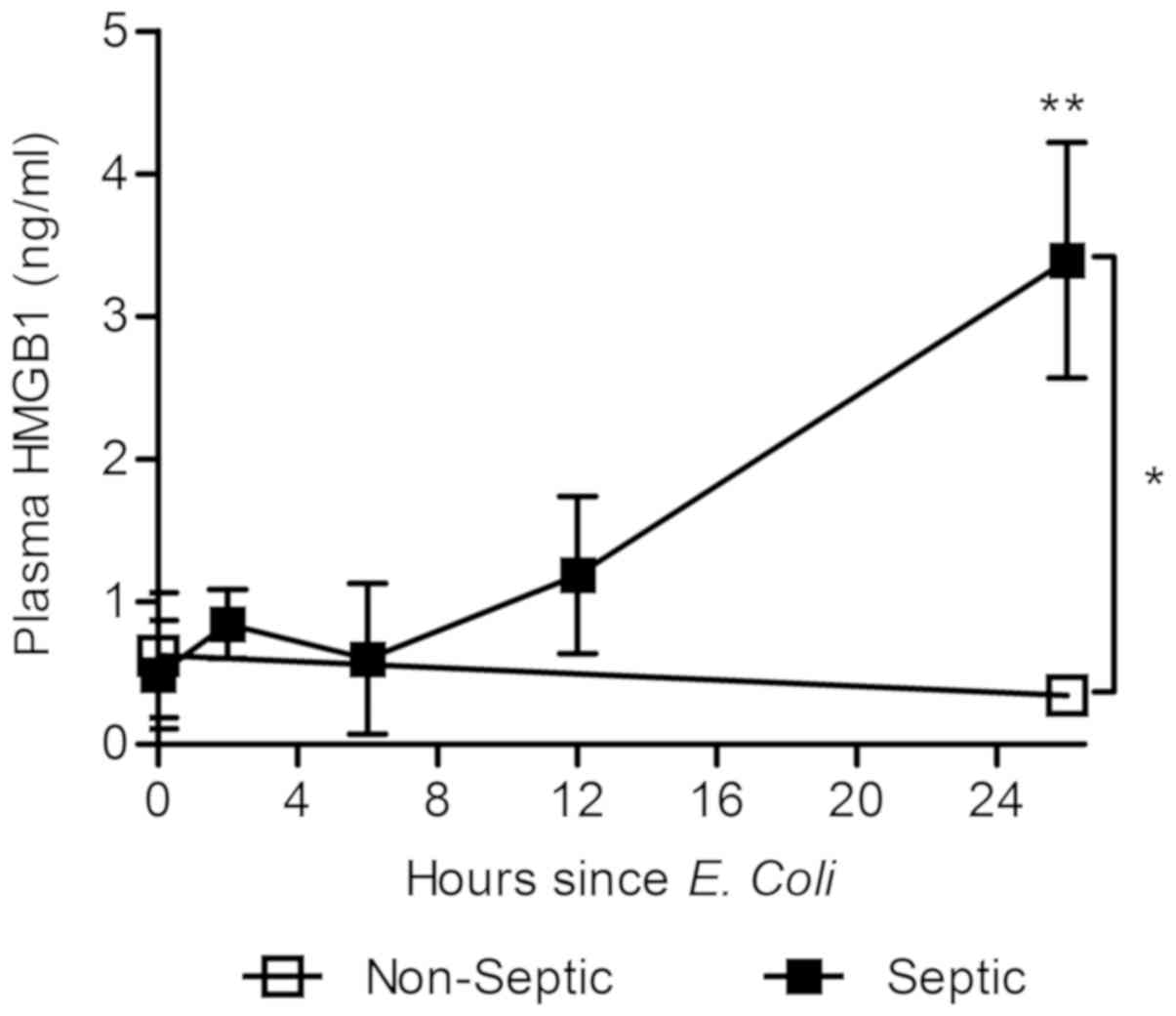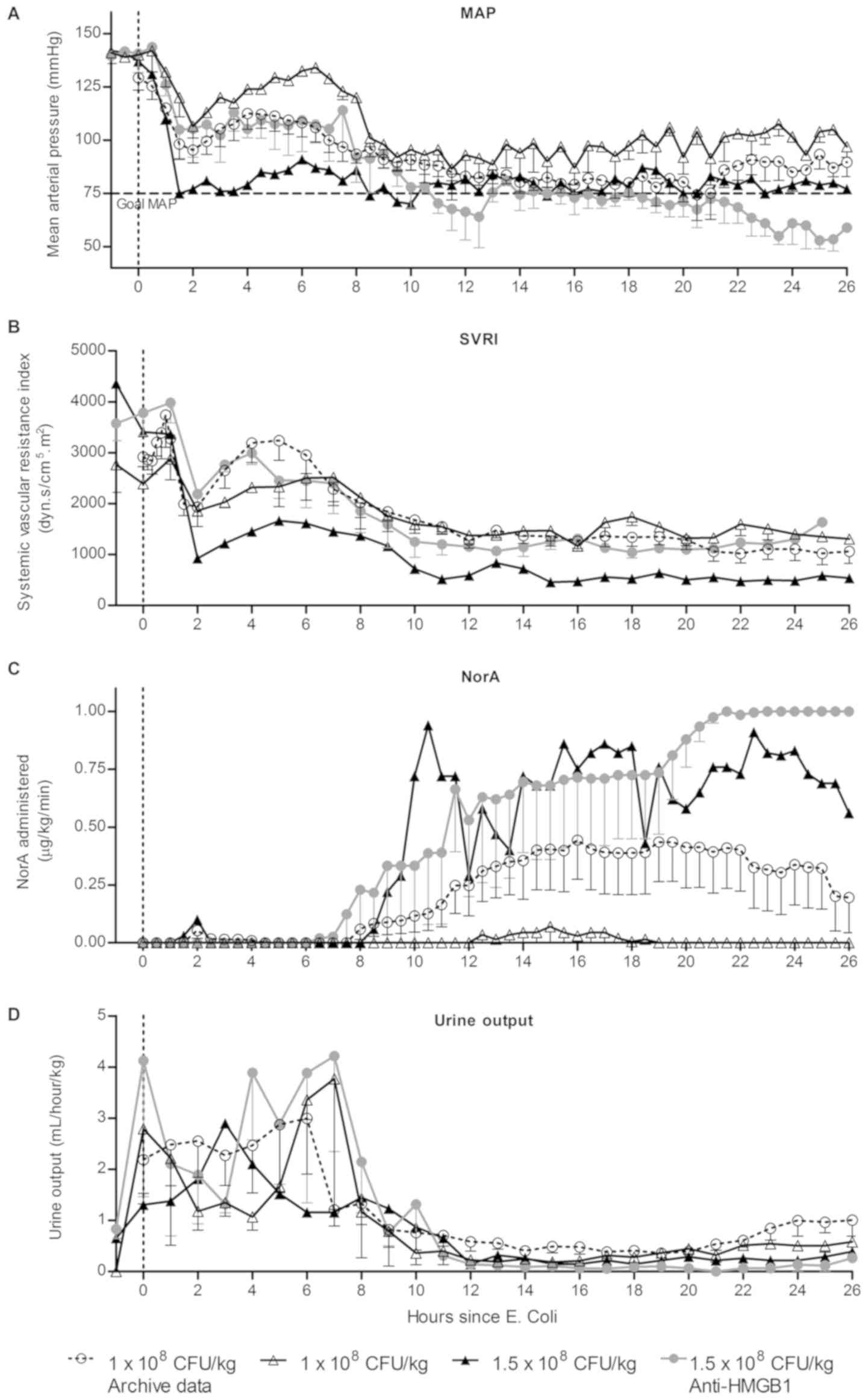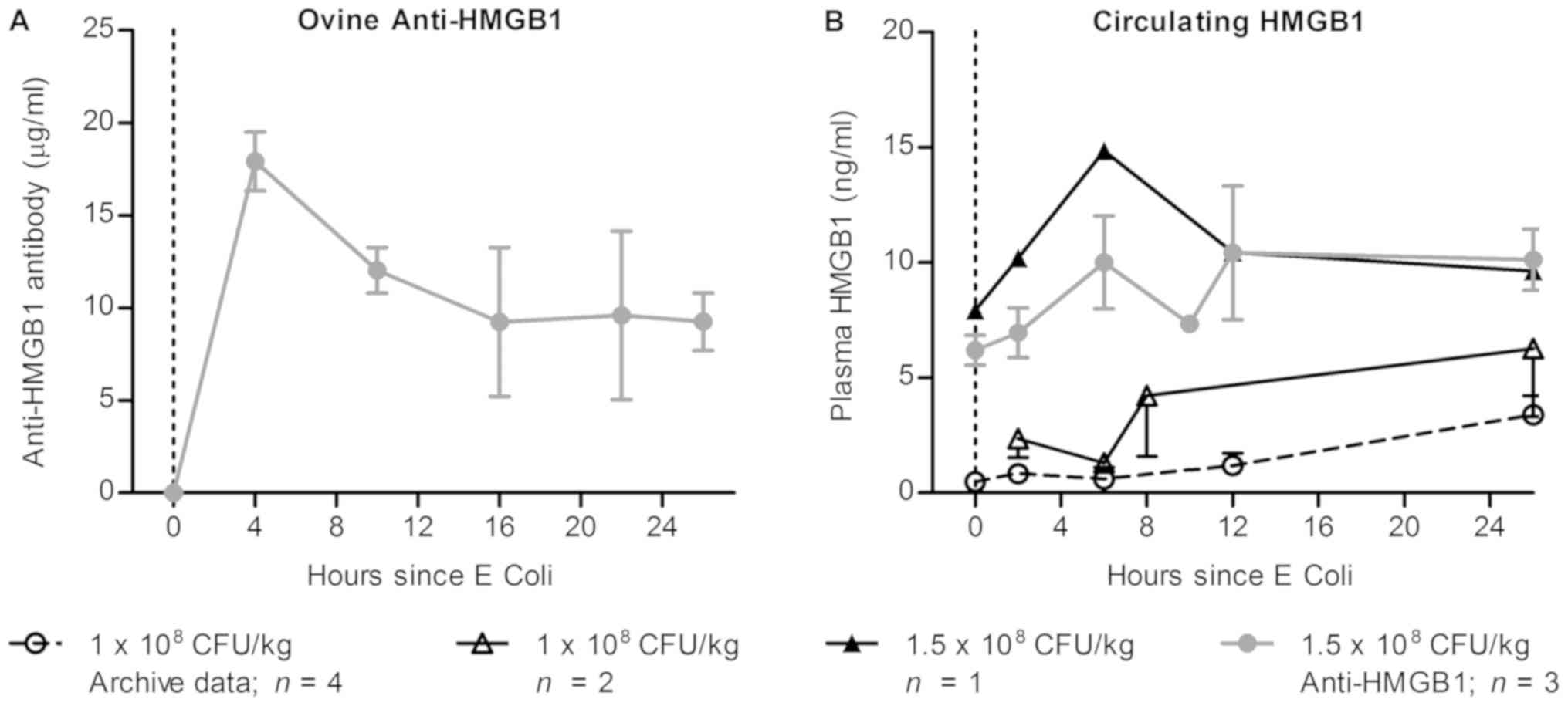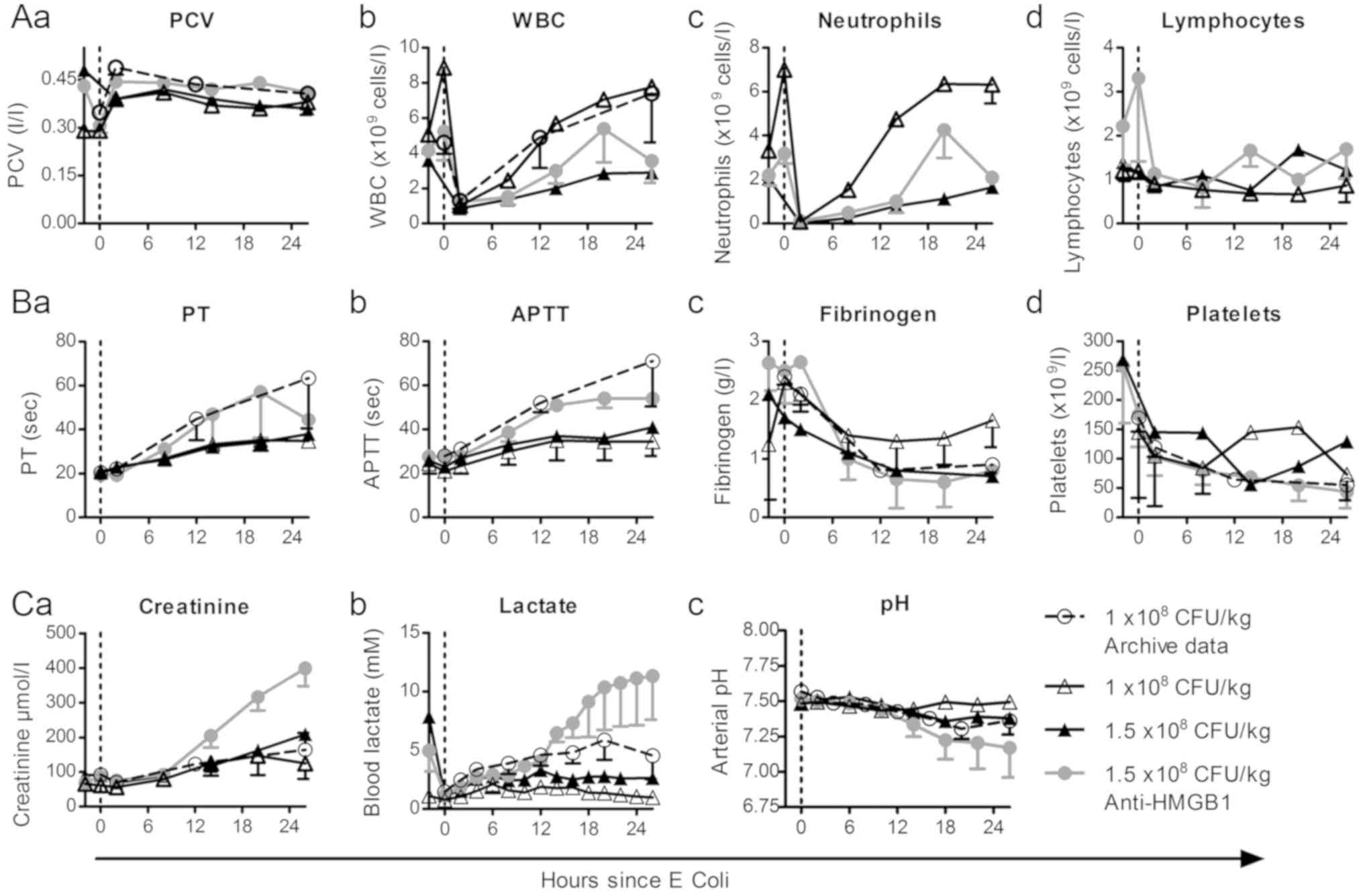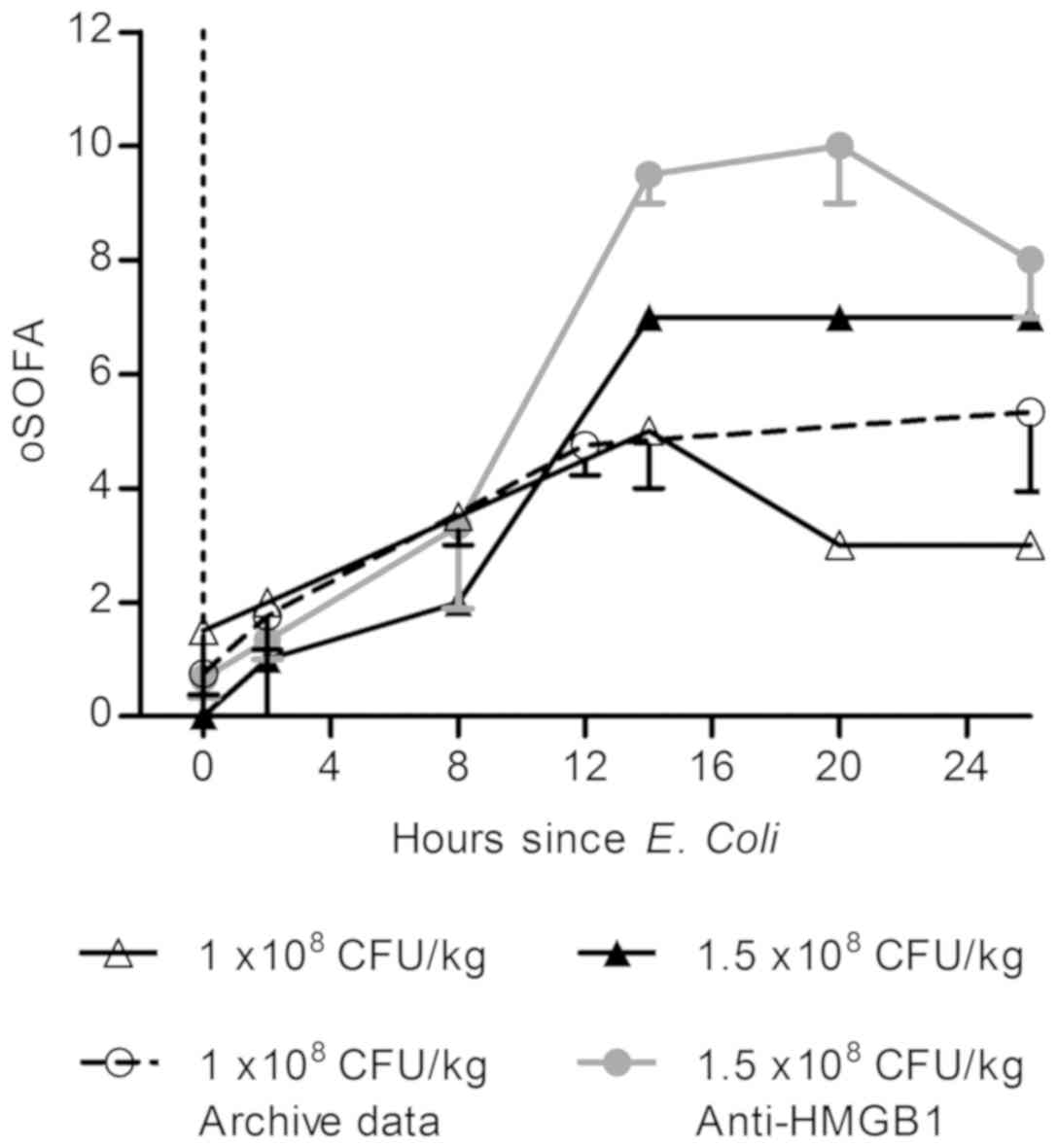|
1
|
Fink MP: Animal models of sepsis.
Virulence. 5:143–153. 2014. View Article : Google Scholar : PubMed/NCBI
|
|
2
|
Nemzek JA, Hugunin KM and Opp MR: Modeling
sepsis in the laboratory: Merging sound science with animal
well-being. Comp Med. 58:120–128. 2008.PubMed/NCBI
|
|
3
|
Seok J, Warren HS, Cuenca AG, Mindrinos
MN, Baker HV, Xu W, Richards DR, McDonald-Smith GP, Gao H, Hennessy
L, et al: Genomic responses in mouse models poorly mimic human
inflammatory diseases. Proc Natl Acad Sci USA. 110:3507–3512. 2013.
View Article : Google Scholar : PubMed/NCBI
|
|
4
|
Takao K and Miyakawa T: Genomic responses
in mouse models greatly mimic human inflammatory diseases. Proc
Natl Acad Sci USA. 112:1167–1172. 2014. View Article : Google Scholar : PubMed/NCBI
|
|
5
|
Di Giantomasso D, Morimatsu H, Bellomo R
and May CN: Effect of low-dose vasopressin infusion on vital organ
blood flow in the conscious normal and septic sheep. Anaesth
Intensive Care. 34:427–433. 2006. View Article : Google Scholar : PubMed/NCBI
|
|
6
|
Singer M, Deutschman CS, Seymour CW,
Shankar-Hari M, Annane D, Bauer M, Bellomo R, Bernard GR, Chiche
JD, Coopersmith CM, et al: The third international consensus
definitions for sepsis and septic shock (Sepsis-3). JAMA.
315:801–810. 2016. View Article : Google Scholar : PubMed/NCBI
|
|
7
|
Pickkers P and Kox M: Towards precision
medicine for sepsis patients. Crit Care. 21:112017. View Article : Google Scholar : PubMed/NCBI
|
|
8
|
Fujishima S: Organ dysfunction as a new
standard for defining sepsis. Inflamm Regen. 36:242016. View Article : Google Scholar : PubMed/NCBI
|
|
9
|
Foley SR, Solano C, Simonova G, Spanevello
MM, Bird RJ, Semple JW, Jackson DE, Schibler A, Fraser JF and Fung
YL: A comprehensive study of ovine haemostasis to assess
suitability to model human coagulation. Thromb Res. 134:468–473.
2014. View Article : Google Scholar : PubMed/NCBI
|
|
10
|
Tapia P, Soto D, Bruhn A, Alegría L,
Jarufe N, Luengo C, Kattan E, Regueira T, Meissner A, Menchaca R,
et al: Impairment of exogenous lactate clearance in experimental
hyperdynamic septic shock is not related to total liver
hypoperfusion. Crit Care. 19:1882015. View Article : Google Scholar : PubMed/NCBI
|
|
11
|
Murakami K, Bjertnaes LJ, Schmalstieg FC,
McGuire R, Cox RA, Hawkins HK, Herndon DN, Traber LD and Traber DL:
A novel animal model of sepsis after acute lung injury in sheep.
Crit Care Med. 30:2083–2090. 2002. View Article : Google Scholar : PubMed/NCBI
|
|
12
|
Su F, Wang Z, Cai Y, Rogiers P and Vincent
JL: Fluid resuscitation in severe sepsis and septic shock: Albumin,
hydroxyethyl starch, gelatin or ringer's lactate-does it really
make a difference? Shock. 27:520–526. 2007. View Article : Google Scholar : PubMed/NCBI
|
|
13
|
Fenhammar J, Rundgren M, Hultenby K,
Forestier J, Taavo M Kenne E, Weitzberg E, Eriksson S, Ozenci V,
Wernerson A and Frithiof R: Renal effects of treatment with a TLR4
inhibitor in conscious septic sheep. Crit Care. 18:4882014.
View Article : Google Scholar : PubMed/NCBI
|
|
14
|
Chapman M, Maiden M, Fraser J, Nash C,
Crichton F, Sideris P and Kuchel T: An ovine intensive care model
of septic shock. Criti Care. 14 (Suppl 1):P42010. View Article : Google Scholar
|
|
15
|
Maiden MJ, Otto S, Brealey JK, Finnis ME,
Chapman MJ, Kuchel TR, Nash CH, Edwards J and Bellomo R: Structure
and function of the kidney in septic shock. A prospective
controlled experimental study. Am J Respir Crit Care Med.
194:692–700. 2016. View Article : Google Scholar : PubMed/NCBI
|
|
16
|
Maiden MJ, Chapman MJ, Torpy DJ, Kuchel
TR, Clarke IJ, Nash CH, Fraser JD and Ludbrook G: Triiodothyronine
administration in a model of septic shock: A randomized blinded
placebo-controlled trial. Crit Care Med. 44:1153–1160. 2016.
View Article : Google Scholar : PubMed/NCBI
|
|
17
|
Gentile LF and Moldawer LL: HMGB1 as a
therapeutic target for sepsis: It's all in the timing! Expert Opin
Ther Targets. 18:243–245. 2014. View Article : Google Scholar : PubMed/NCBI
|
|
18
|
Andersson U and Tracey KJ: HMGB1 is a
therapeutic target for sterile inflammation and infection. Annu Rev
Immunol. 29:139–162. 2011. View Article : Google Scholar : PubMed/NCBI
|
|
19
|
Lakhan N, Stevens NE, Diener KR and
Hayball JD: CoVaccine HT™ adjuvant is superior to Freund's
adjuvants in eliciting antibodies against the endogenous alarmin
HMGB1. J Immunol Methods. 439:37–43. 2016. View Article : Google Scholar : PubMed/NCBI
|
|
20
|
Stevens NE, Chapman MJ, Fraser CK, Kuchel
TR, Hayball JD and Diener KR: Therapeutic targeting of HMGB1 during
experimental sepsis modulates the inflammatory cytokine profile to
one associated with improved clinical outcomes. Sci Rep.
7:58502017. View Article : Google Scholar : PubMed/NCBI
|
|
21
|
Suda K, Kitagawa Y, Ozawa S, Saikawa Y,
Ueda M, Ebina M, Yamada S, Hashimoto S, Fukata S, Abraham E, et al:
Anti-high-mobility group box chromosomal protein 1 antibodies
improve survival of rats with sepsis. World J Surg. 30:1755–1762.
2006. View Article : Google Scholar : PubMed/NCBI
|
|
22
|
Fleischmann C, Thomas-Rueddel DO, Hartmann
M, Hartog CS, Welte T, Heublein S, Dennler U and Reinhart K:
Hospital incidence and mortality rates of sepsis. Dtsch Arztebl
Int. 113:159–166. 2016.PubMed/NCBI
|
|
23
|
Regan JK, Kannan PS, Kemp MW, Kramer BW,
Newnham JP, Jobe AH and Kallapur SG: Damage-associated molecular
pattern and fetal membrane vascular injury and collagen
disorganization in lipopolysaccharide-induced intra-amniotic
inflammation in fetal sheep. Reprod Sci. 23:69–80. 2015. View Article : Google Scholar : PubMed/NCBI
|
|
24
|
Gabrielyan A, Knaak S, Gelinsky M, Arnhold
S and Rösen-Wolff A: Hypoxia-conditioned media allows
species-specific attraction of bone marrow stromal cells without
need for recombinant proteins. BMC Vet Res. 10:562013. View Article : Google Scholar
|
|
25
|
Frasch MG, Szynkaruk M, Prout AP, Nygard
K, Cao M, Veldhuizen R, Hammond R and Richardson BS: Decreased
neuroinflammation correlates to higher vagus nerve activity
fluctuations in near-term ovine fetuses: A case for the afferent
cholinergic anti-inflammatory pathway? J Neuroinflammation.
13:1032016. View Article : Google Scholar : PubMed/NCBI
|
|
26
|
Tabrizi M, Bornstein GG and Suria H:
Biodistribution mechanisms of therapeutic monoclonal antibodies in
health and disease. AAPS J. 12:33–43. 2009. View Article : Google Scholar : PubMed/NCBI
|
|
27
|
Ito I, Fukazawa J and Yoshida M:
Post-translational methylation of high mobility group box 1 (HMGB1)
causes its cytoplasmic localization in neutrophils. J Biol Chem.
282:16336–16344. 2007. View Article : Google Scholar : PubMed/NCBI
|
|
28
|
Jain S, Gautam V and Naseem S: Acute-phase
proteins: As diagnostic tool. J Pharm Bioallied Sci. 3:118–127.
2011. View Article : Google Scholar : PubMed/NCBI
|
|
29
|
Michel O, Nagy AM, Schroeven M, Duchateau
J, Nève J, Fondu P and Sergysels R: Dose-response relationship to
inhaled endotoxin in normal subjects. Am J Respir Crit Care Med.
156:1157–1164. 1997. View Article : Google Scholar : PubMed/NCBI
|
|
30
|
Kreger BE, Craven DE and McCabe WR:
Gram-negative bacteremia. IV. Re-evaluation of clinical features
and treatment in 612 patients. Am J Med. 68:344–355. 1980.
View Article : Google Scholar : PubMed/NCBI
|
|
31
|
Hara T, Shimizu K, Ogawa F, Yanaba K,
Iwata Y, Muroi E, Takenaka M, Komura K, Hasegawa M, Fujimoto M and
Sato S: Platelets control leukocyte recruitment in a murine model
of cutaneous arthus reaction. Am J Pathol. 176:259–269. 2009.
View Article : Google Scholar : PubMed/NCBI
|
|
32
|
Ishikura H, Nakamura Y, Kawano Y, Tanaka
J, Mizunuma M, Ohta D, Nishida T and Murai A: Intravenous
immunoglobulin improves sepsis-induced coagulopathy: A
retrospective, single-center observational study. J Crit Care.
30:579–583. 2015. View Article : Google Scholar : PubMed/NCBI
|
|
33
|
Fink MP and Warren HS: Strategies to
improve drug development for sepsis. Nat Rev Drug Discov.
13:741–758. 2014. View Article : Google Scholar : PubMed/NCBI
|
|
34
|
Opal SM, Dellinger RP, Vincent JL, Masur H
and Angus DC: The next generation of sepsis clinical trial designs:
What is next after the demise of recombinant human activated
protein C?*. Crit Care Med. 42:1714–1721. 2014. View Article : Google Scholar : PubMed/NCBI
|
|
35
|
Mebazaa A, Laterre PF, Russell JA,
Bergmann A, Gattinoni L, Gayat E, Harhay MO, Hartmann O, Hein F,
Kjolbye AL, et al: Designing phase 3 sepsis trials: Application of
learned experiences from critical care trials in acute heart
failure. J Intensive Care. 4:242016. View Article : Google Scholar : PubMed/NCBI
|
|
36
|
Shrum B, Anantha RV, Xu SX, Donnelly M,
Haeryfar SM, McCormick JK and Mele T: A robust scoring system to
evaluate sepsis severity in an animal model. BMC Res Notes.
7:2332014. View Article : Google Scholar : PubMed/NCBI
|
|
37
|
Sathe PM and Patwa UD: D Dimer in acute
care. Int J Crit Illn Inj Sci. 4:229–232. 2014. View Article : Google Scholar : PubMed/NCBI
|















